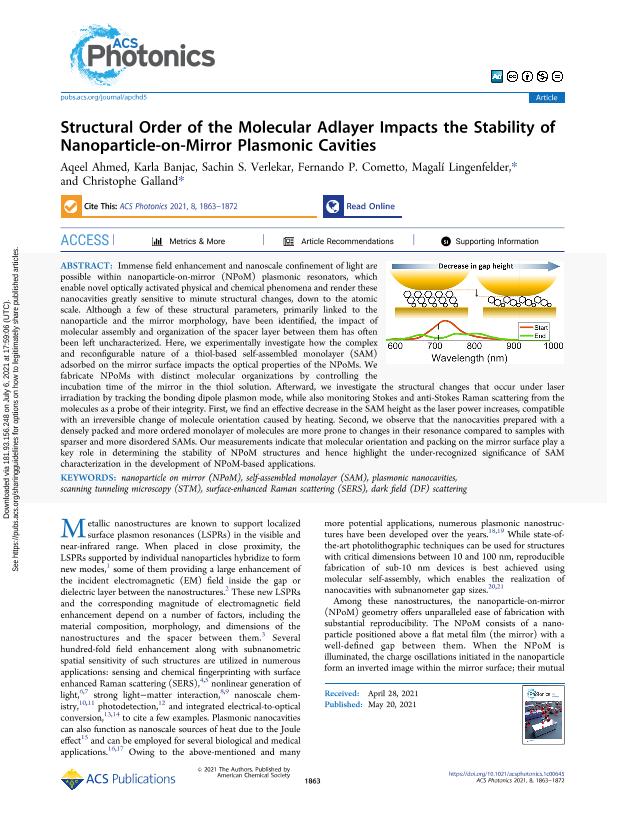Mostrar el registro sencillo del ítem
dc.contributor.author
Ahmed, Aqeel
dc.contributor.author
Banjac, Karla
dc.contributor.author
Verlekar, Sachin S.
dc.contributor.author
Cometto, Fernando Pablo

dc.contributor.author
Lingenfelder, Magalí Alejandra

dc.contributor.author
Galland, Christophe
dc.date.available
2022-10-13T12:59:44Z
dc.date.issued
2021-06
dc.identifier.citation
Ahmed, Aqeel; Banjac, Karla; Verlekar, Sachin S.; Cometto, Fernando Pablo; Lingenfelder, Magalí Alejandra; et al.; Structural Order of the Molecular Adlayer Impacts the Stability of Nanoparticle-on-Mirror Plasmonic Cavities; American Chemical Society; ACS Photonics; 8; 6; 6-2021; 1863-1872
dc.identifier.uri
http://hdl.handle.net/11336/172908
dc.description.abstract
Immense field enhancement and nanoscale confinement of light are possible within nanoparticle-on-mirror (NPoM) plasmonic resonators, which enable novel optically activated physical and chemical phenomena and render these nanocavities greatly sensitive to minute structural changes, down to the atomic scale. Although a few of these structural parameters, primarily linked to the nanoparticle and the mirror morphology, have been identified, the impact of molecular assembly and organization of the spacer layer between them has often been left uncharacterized. Here, we experimentally investigate how the complex and reconfigurable nature of a thiol-based self-Assembled monolayer (SAM) adsorbed on the mirror surface impacts the optical properties of the NPoMs. We fabricate NPoMs with distinct molecular organizations by controlling the incubation time of the mirror in the thiol solution. Afterward, we investigate the structural changes that occur under laser irradiation by tracking the bonding dipole plasmon mode, while also monitoring Stokes and anti-Stokes Raman scattering from the molecules as a probe of their integrity. First, we find an effective decrease in the SAM height as the laser power increases, compatible with an irreversible change of molecule orientation caused by heating. Second, we observe that the nanocavities prepared with a densely packed and more ordered monolayer of molecules are more prone to changes in their resonance compared to samples with sparser and more disordered SAMs. Our measurements indicate that molecular orientation and packing on the mirror surface play a key role in determining the stability of NPoM structures and hence highlight the under-recognized significance of SAM characterization in the development of NPoM-based applications.
dc.format
application/pdf
dc.language.iso
eng
dc.publisher
American Chemical Society
dc.rights
info:eu-repo/semantics/openAccess
dc.rights.uri
https://creativecommons.org/licenses/by-nc-nd/2.5/ar/
dc.subject
DARK FIELD (DF) SCATTERING
dc.subject
NANOPARTICLE ON MIRROR (NPOM)
dc.subject
PLASMONIC NANOCAVITIES
dc.subject
SCANNING TUNNELING MICROSCOPY (STM)
dc.subject
SELF-ASSEMBLED MONOLAYER (SAM)
dc.subject
SURFACE-ENHANCED RAMAN SCATTERING (SERS)
dc.subject.classification
Físico-Química, Ciencia de los Polímeros, Electroquímica

dc.subject.classification
Ciencias Químicas

dc.subject.classification
CIENCIAS NATURALES Y EXACTAS

dc.title
Structural Order of the Molecular Adlayer Impacts the Stability of Nanoparticle-on-Mirror Plasmonic Cavities
dc.type
info:eu-repo/semantics/article
dc.type
info:ar-repo/semantics/artículo
dc.type
info:eu-repo/semantics/publishedVersion
dc.date.updated
2022-09-21T23:31:45Z
dc.identifier.eissn
2330-4022
dc.journal.volume
8
dc.journal.number
6
dc.journal.pagination
1863-1872
dc.journal.pais
Estados Unidos

dc.journal.ciudad
Washington
dc.description.fil
Fil: Ahmed, Aqeel. École Polytechnique Fédérale de Lausanne; Suiza
dc.description.fil
Fil: Banjac, Karla. École Polytechnique Fédérale de Lausanne; Suiza
dc.description.fil
Fil: Verlekar, Sachin S.. École Polytechnique Fédérale de Lausanne; Suiza
dc.description.fil
Fil: Cometto, Fernando Pablo. Consejo Nacional de Investigaciones Científicas y Técnicas. Centro Científico Tecnológico Conicet - Córdoba. Instituto de Investigaciones en Físico-química de Córdoba. Universidad Nacional de Córdoba. Facultad de Ciencias Químicas. Instituto de Investigaciones en Físico-química de Córdoba; Argentina. École Polytechnique Fédérale de Lausanne; Suiza. Universidad Nacional de Córdoba. Facultad de Ciencias Químicas. Departamento de Fisicoquímica; Argentina
dc.description.fil
Fil: Lingenfelder, Magalí Alejandra. École Polytechnique Fédérale de Lausanne; Suiza
dc.description.fil
Fil: Galland, Christophe. École Polytechnique Fédérale de Lausanne; Suiza
dc.journal.title
ACS Photonics
dc.relation.alternativeid
info:eu-repo/semantics/altIdentifier/doi/http://dx.doi.org/10.1021/acsphotonics.1c00645
dc.relation.alternativeid
info:eu-repo/semantics/altIdentifier/url/https://pubs.acs.org/doi/10.1021/acsphotonics.1c00645
Archivos asociados
